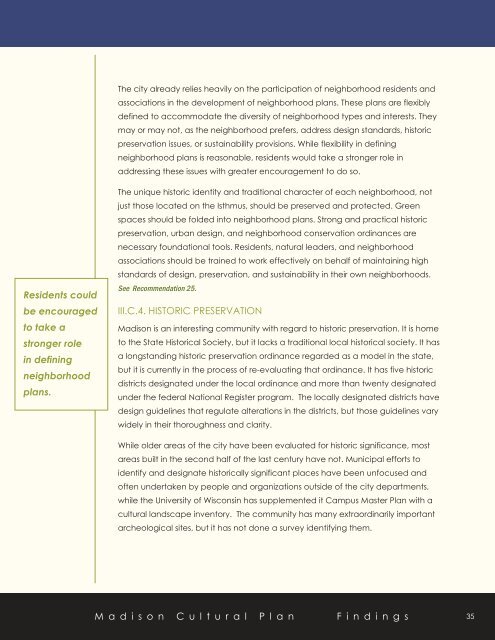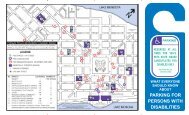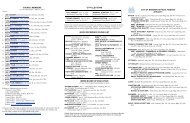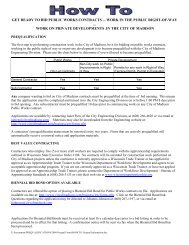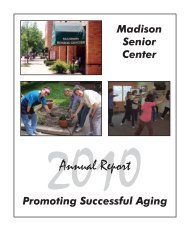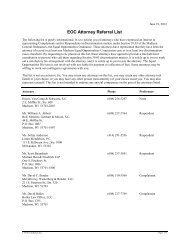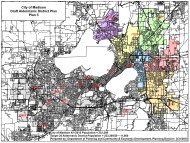Madison Cultural Plan 2011 - City of Madison, Wisconsin
Madison Cultural Plan 2011 - City of Madison, Wisconsin
Madison Cultural Plan 2011 - City of Madison, Wisconsin
You also want an ePaper? Increase the reach of your titles
YUMPU automatically turns print PDFs into web optimized ePapers that Google loves.
Residents could<br />
be encouraged<br />
to take a<br />
stronger role<br />
in defining<br />
neighborhood<br />
plans.<br />
The city already relies heavily on the participation <strong>of</strong> neighborhood residents and<br />
associations in the development <strong>of</strong> neighborhood plans. These plans are flexibly<br />
defined to accommodate the diversity <strong>of</strong> neighborhood types and interests. They<br />
may or may not, as the neighborhood prefers, address design standards, historic<br />
preservation issues, or sustainability provisions. While flexibility in defining<br />
neighborhood plans is reasonable, residents would take a stronger role in<br />
addressing these issues with greater encouragement to do so.<br />
The unique historic identity and traditional character <strong>of</strong> each neighborhood, not<br />
just those located on the Isthmus, should be preserved and protected. Green<br />
spaces should be folded into neighborhood plans. Strong and practical historic<br />
preservation, urban design, and neighborhood conservation ordinances are<br />
necessary foundational tools. Residents, natural leaders, and neighborhood<br />
associations should be trained to work effectively on behalf <strong>of</strong> maintaining high<br />
standards <strong>of</strong> design, preservation, and sustainability in their own neighborhoods.<br />
See Recommendation 25.<br />
III.C.4. HISTORIC PRESERVATION<br />
<strong>Madison</strong> is an interesting community with regard to historic preservation. It is home<br />
to the State Historical Society, but it lacks a traditional local historical society. It has<br />
a longstanding historic preservation ordinance regarded as a model in the state,<br />
but it is currently in the process <strong>of</strong> re-evaluating that ordinance. It has five historic<br />
districts designated under the local ordinance and more than twenty designated<br />
under the federal National Register program. The locally designated districts have<br />
design guidelines that regulate alterations in the districts, but those guidelines vary<br />
widely in their thoroughness and clarity.<br />
While older areas <strong>of</strong> the city have been evaluated for historic significance, most<br />
areas built in the second half <strong>of</strong> the last century have not. Municipal efforts to<br />
identify and designate historically significant places have been unfocused and<br />
<strong>of</strong>ten undertaken by people and organizations outside <strong>of</strong> the city departments,<br />
while the University <strong>of</strong> <strong>Wisconsin</strong> has supplemented it Campus Master <strong>Plan</strong> with a<br />
cultural landscape inventory. The community has many extraordinarily important<br />
archeological sites, but it has not done a survey identifying them.<br />
<strong>Madison</strong> <strong>Cultural</strong> <strong>Plan</strong> Findings<br />
35


